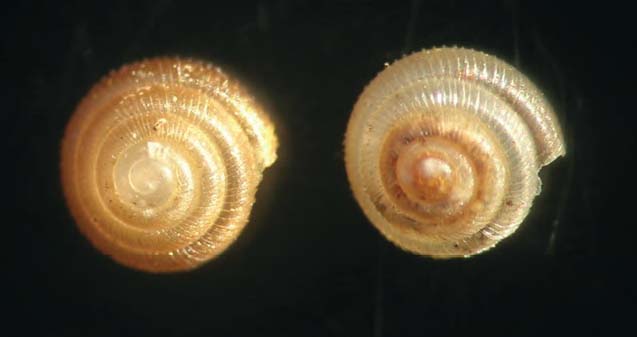Issue
17
Page
14
Species
 Spermodea lamellata is a terrestrial mollusc which has a north-westerly distribution in Britain and is associated with ancient semi-natural woodland. Its shell colour exhibits little variation and is described succinctly by Kerney & Cameron (1979) as “pale golden-brown, slightly translucent”. Earlier authors provide similar descriptions, for example “grey or pale horn colour….the tip obtuse and usually of a whitish colour (Gray 1857), “yellowish horn colour or tawny” (Jeffreys 1862-9), “greyish” (Tate 1866), “yellowish horn colour. The spire of the shell, especially at the apex, is frequently denuded of its epidermis” (Rimmer 1880). Adams (1896) describes it as a “horn colour” and adds with delightfully dry humour, “It is one of those few species of which no one has been ingenious enough to find varieties”. However, thirty years later Ellis (1926) listed “var albina”, described as “a rare white-shelled form”.
Spermodea lamellata is a terrestrial mollusc which has a north-westerly distribution in Britain and is associated with ancient semi-natural woodland. Its shell colour exhibits little variation and is described succinctly by Kerney & Cameron (1979) as “pale golden-brown, slightly translucent”. Earlier authors provide similar descriptions, for example “grey or pale horn colour….the tip obtuse and usually of a whitish colour (Gray 1857), “yellowish horn colour or tawny” (Jeffreys 1862-9), “greyish” (Tate 1866), “yellowish horn colour. The spire of the shell, especially at the apex, is frequently denuded of its epidermis” (Rimmer 1880). Adams (1896) describes it as a “horn colour” and adds with delightfully dry humour, “It is one of those few species of which no one has been ingenious enough to find varieties”. However, thirty years later Ellis (1926) listed “var albina”, described as “a rare white-shelled form”.North East Yorkshire (vice-county 62) is something of a stronghold for this very locally distributed species, where it occurs in a number of old woodlands. Here, Hawell (1899) commented “The Kildale specimens are often much lighter than those at Ingleby, and the apex is often of a reddish tint”. Another local naturalist, Bernard Lucas, assembled a collection of land and freshwater shells which he presented to the Darlington and Teesdale Naturalists’ Field Club in November 1928. Among these are four white shelled Spermodea lamellata labelled “ACANTHINULA LAMELLATA Jeff. Kildale 4/5/28 BRL”.
During current work in the area, S. lamellata was first located in the Kildale area in Mill Bank Wood (grid ref. NZ599098) on 1st June 1996 and has been recorded here on a number of occasions since. As part of a more detailed investigation into the habitat occupied by this species a leaf litter sample of approximately 2 litres was collected from one of the known sites for this species in Mill Bank Wood on 18th August 2007. The litter was mainly beech (Fagus sylvatica) with some oak (Quercus sp.). Fifty individuals were recovered from this sample by hand searching. Of these, 29 were white shelled and 21 pale brown (Figure), the latter showing little colour variation. The comment by Ellis (1926), quoted above, that the white shelled variety is rare seems to be borne out in NE Yorkshire in that this is the only site where it has been found to date form over 20 where this species is known to occur. It is possible however that white shelled individuals may have been overlooked as the colour is not immediately obvious owing to the underlying body colour showing through the somewhat translucent shell.
References
Adams, L.E. (1896) The Collector’s Manual of British Land and Freshwater Shells. Taylor Brothers, Leeds.
Ellis, A. E. (1926) British Snails. Clarendon Press, Oxford. Gray, J.E. (1857) Manual of the Land and Fresh-Water Shells of the British Isles (Turton). New edition. Longman, London.
Hawell, J. (1899) List of the Mollusca of the Cleveland District. Cleveland Nat. Fld. Club Rec. Proc. 1: 19-34. Jeffreys, J.G. (1862-9) British Conchology. London.
Kerney, M.P. & Cameron R.A.D. (1979) A Field Guide to the Land Snails of Britain and North-West Europe. Collins, London.
Rimmer, R. (1880) The Land and Freshwater Shells of the British Isles. John Grant, Edinburgh.
Tate, R. (1866) The Land and Fresh- Water Mollusks of Great Britain. Robert Hardwicke, London.
